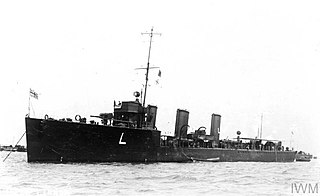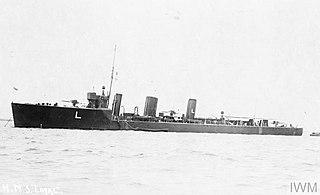Description
The Talismans were designed by Armstrong Whitworth for the Ottoman Navy, but were sub-contracted to Hawthorn Leslie and Company for building. [1] They displaced 1,098 long tons (1,116 t). The ships had an overall length of 309 feet (94.2 m), a beam of 28 feet 7 inches (8.7 m) and a draught of 9 feet 6 inches (2.9 m). They were powered by three Parsons direct-drive steam turbines, each driving one propeller shaft, using steam provided by three Yarrow boilers. The turbines developed a total of 25,000 shaft horsepower (19,000 kW) and gave a maximum speed of 32 knots (59 km/h; 37 mph). The ships carried a maximum of 237 long tons (241 t) of fuel oil. The ships' complement was 102 officers and ratings. [2] The hull form was considered particularly successful and was adopted for the V and W class of 1917, arguably the peak of destroyer development at the time.
The Talisman-class ships were heavily armed for their time, shipping five single QF 4-inch (102 mm) Mark IV guns. Two of the guns were side by side on the forecastle. The other guns were carried on the centreline; one between the first and second funnels, one after the searchlight platform and one on a bandstand on the quarterdeck. All the guns had half-shields. [2] The ships were designed to accommodate three above water twin mounts for 21-inch (533 mm) torpedoes, but only two mounts were fitted in British service. [3]

HMS Lydiard was a Laforey-class destroyer built for the Royal Navy during the 1910s.

The Beagle class was a class of sixteen destroyers of the Royal Navy, all ordered under the 1908-1909 programme and launched in 1909 and 1910. The Beagles served during World War I, particularly during the Dardanelles Campaign of 1915.

The first HMS Zulu was a Tribal class destroyer launched 16 September 1909 at Hawthorn Leslie Shipyard and commissioned in March 1910. She was mined during the First World War, on 27 October 1916 off Dover in a minefield lain by the Imperial German submarine UC-1. Her stern was blown off and sank, but the forward section remained afloat. It was towed into port and attached to the stern of Nubian, which had been torpedoed, to form a new destroyer named HMS Zubian.

The Acorn class was a class of twenty destroyers of the Royal Navy all built under the 1909-1910 Programme, and completed between 1910 and 1911. The Acorns served during World War I.
HMS Turbulent was one of four Talisman-class destroyers ordered for the Ottoman Navy and taken over by the Royal Navy during the First World War.
HMS Phoebe was an Admiralty M-class destroyer built for the Royal Navy during the First World War. She took part in the Zeebrugge Raid in 1918 and was sold for scrap in 1921.
HMS Goldfinch was an Acorn-class destroyer built for the Royal Navy. Completed in 1911, the ship spent her career in home waters and participated in the First World War as part of the Grand Fleet. She was wrecked in fog on Start Point, Sanday, one of the northern Orkney Isles, on the night of 18–19 February 1915. Her wreck was broken up for scrap in April 1919.
HMS Lassoo was a Laforey-class destroyer built for the Royal Navy during the 1910s.
HMS Turbulent was an S-class destroyer built for the Royal Navy during the First World War.
HMS Ophelia was an Admiralty M-class destroyer built for the Royal Navy during the First World War, entering service in 1916. The ship served at the Battle of Jutland on 31 May/1 June 1916, and sank a German submarine in 1918. She was sold for scrap in 1921.

HMS Legion was a Laforey-class destroyer built for the Royal Navy during the 1910s.

HMS Lennox was a Laforey-class destroyer built for the Royal Navy during the 1910s.

HMS Loyal was a Laforey-class destroyer built for the Royal Navy during the 1910s.
HMS Onslow was an Admiralty M-class destroyer built for the Royal Navy during the First World War. She took part in the Battle of Jutland in 1916 and was sold for scrap in 1921.

HMS Louis was a Laforey-class destroyer built for the British Royal Navy during the 1910s. She participated in the Dardanelles campaign, during which she was wrecked in Suvla Bay in 1915.
HMS Narborough was an Admiralty M-class destroyer built for the Royal Navy during the First World War. She was wrecked after running aground in 1918.

HMS Scythe was an S-class destroyer built for the Royal Navy during the First World War. She was involved in the Irish Civil War in the interwar period before being sold for scrap in 1931.

HMS Partridge was a Royal Navy Admiralty M-class destroyer constructed and then operational in the First World War, later being sunk by enemy action in 1917. The destroyer was the sixth Royal Navy vessel to carry the name HMS Partridge.
HMS Pheasant was one of 85 Admiralty M-class destroyers built during the First World War for the Royal Navy. She hit and was sunk by a mine in 1917.
HMS Recruit was a R-class destroyer built for the Royal Navy during the First World War. She was sunk by a German U-boat four months after she was commissioned in April 1917.
This page is based on this
Wikipedia article Text is available under the
CC BY-SA 4.0 license; additional terms may apply.
Images, videos and audio are available under their respective licenses.










